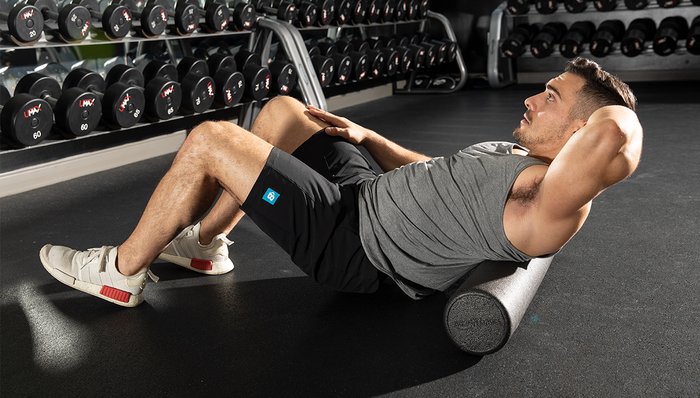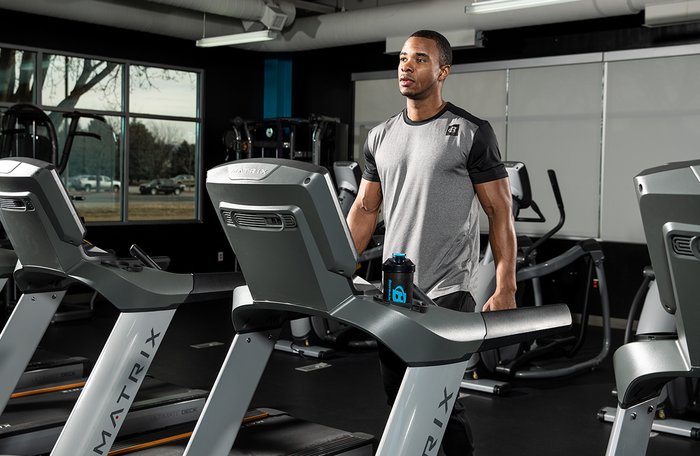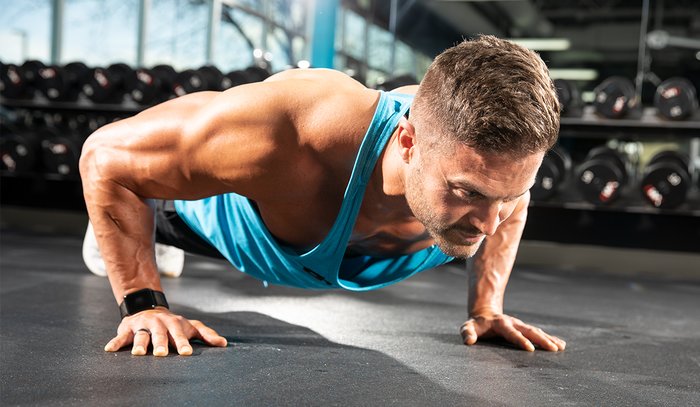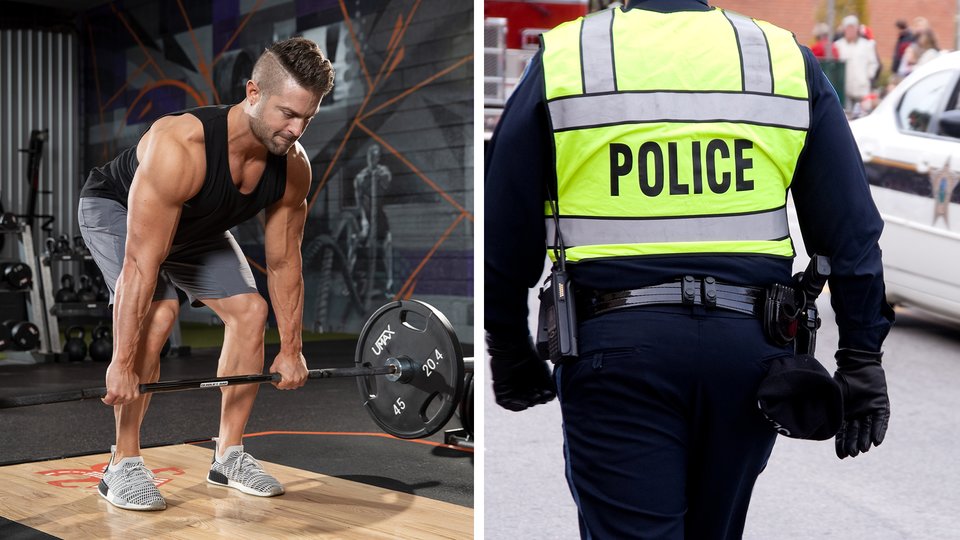Products You May Like
If sitting is the new smoking, there are few populations more at risk than the modern patrol officer.
Twelve hours in a vehicle, most of them spent in an awkward right twist to access the built-in computer, can definitely take its toll on an officer’s posture, strength, and flexibility—not to mention their overall health! But unlike the rest of us, an officer must also be able to go from a sit to a sprint in an instant, drawn into a foot pursuit he or she is duty-bound to win. Not to mention, it’s likely to end up in a fight they can’t afford to lose.
The key to weathering these spontaneous, dynamic bursts of athleticism requires careful thought and preparation, which cops are generally prepared to invest. But it also requires something law enforcement officers (LEOs) have little to spare: time.
Sure, the majority of agencies in the country work on a “three 12s” schedule, meaning three consecutive days of 12-hour shifts, followed by four days off. But anyone who does that type of shift work knows it often comes down to the choice between a good sweat or an extra hour of precious sleep. And on those days off, gym time competes with errands, kids’ games, honey-do lists, and general recovery. In other words, life.
LEOs—especially those with years of lifting experience—have been taught to expect workouts to last—or exceed—90 minutes. But the truth is you can become significantly stronger, faster, and more functional in far less time per session.
Whether you carry 20-30 pounds of life-saving gear around all day, or you’re just someone in search of more time-efficient training protocols, these goal-specific 30-minute workouts have you covered. Use them either as a standalone weekly routine or as a supplement to your existing routine.
As always, be wary of training so much as to stall your gains, make you more susceptible to injury, or adversely impact your performance on the job. Maintain your recovery by following your workouts with 3-5 minutes of static stretching and deep-tissue work on a foam roller.

Strength Training for Patrol Officers
There may be no more important physical trait for LEOs than being pound-for-pound stronger than those they contact on the street. Physical skills and combative training are absolutely essential, but the stronger person will always have an advantage in a physical confrontation. Strength is vital in every task an officer will be called upon to perform, from breaking up a bar fight to pulling a victim to safety.
While there are many ways to increase strength, if we paint with a broad brush, the best approach involves lifting heavy weight for a few picture-perfect reps. Powerlifters often train at or near-maximum loads, but take up to 5 minutes of rest between sets and exercises. Officers don’t have time for that!
Here, we’ll utilize the CrossFit-inspired “every minute on the minute” (EMOM) approach, but dialed back for a strength focus. Don’t make this a WOD! Keep in mind that strength building is primarily a central nervous system (CNS) adaptation, and moving big weight quickly and more often can beget rapid increases in weight used.
Implementing shorter rest times can also act as a form of conditioning, helping to keep your body composition in check to avoid an unsightly overflow out of the bottom of your ballistic vest. Here’s to looking better in that uniform!
Strength Workout Notes
- Perform a general dynamic warm-up before your deadlifts. It should include 3-5 minutes of activities such as leg swings, bodyweight Romanian deadlifts with a PVC pipe, lunges, inchworms, and movement-focused mobility work.
- For each exercise here, select a weight you can handle for 8-10 reps, but only complete 3-5 each set, focusing on perfect form and maximum speed on each rep. At every minute mark, you’ll complete your 3-5 reps, then rest until the next minute mark before doing the next set.
- After your deadlifts, perform some dynamic upper-body moves such as arm swings and band pull-aparts to redirect blood flow into your pecs, delts, and lats.
- Perform 1-2 unweighted sets of pull-ups and dips before adding weight, and unless you’re a beast, limit your extra weight to 20-30 pounds. If you can’t complete 3-5 reps for all 10 sets, drop or eliminate weight until you are able to do so.
Speed Training for Patrol Officers
Consider a nightmare scenario in which an officer must pursue a potentially armed suspect as he or she approaches, say, a schoolyard full of children. Law and policy will dictate the amount of force an officer can use to stop the threat, but a better bet may be a good old-fashioned, open-field tackle from behind after closing the distance.
If running your Baker-to-Vegas leg every year is your only relationship with running, well, you’re still probably in a better position to run down a felon than most. But when was the last time you redlined your motor on a sprint? No matter if you’re in your 20s, 30s, or 40s—and regardless of whether you wear a badge or have a beat—sprints should be part of your routine.

Sprints have many benefits, including muscle preservation (or even growth), elevated testosterone, and increased metabolism for greater fat burning. Plus, you won’t have to explain to your sergeant why you were outrun by Tyrone Biggums.
You’ll start the workout with ice skaters (also known sometimes as speed skaters) to strengthen your ankles and knees against change-of-direction injuries, and jumping rope to prime your CNS to spend as little time as possible in contact with the ground. The weighted sprints (with an extra 20-30 pounds) replicate the task of running in duty gear while also prepping you for greater performance on your flat-ground, unweighted sprints.
Speed Workout Notes
- Perform a general dynamic warm-up ahead of your first set of ice skaters. It should include 3-5 minutes of activities such as jogging, jumping jacks, butt kicks, leg swings, and movement-focused mobility work for your ankles and shoulders.
- For each 20-second segment of your ice skaters, hop quickly from side to side, covering as much ground as possible while spending as little time in contact with the ground as possible.
- With the jump rope, vary your cadence and landing spots and move from two- to one-foot jumps for the 3 minutes.
- Each sprint should be a maximum effort. Run as fast as you can with good form. Rest 80-100 seconds between sprints, which is optimal for the recovery of your explosive energy stores.
Functional Conditioning for Patrol Officers
Those assigned to your department’s motor pool are responsible for keeping your black-and-whites running at top speed. When you summon those 350 ponies with a press of the gas pedal, they should respond with enthusiasm! But when it comes to your body, you’re the only one responsible for maintaining what’s under the hood.

General conditioning is valuable because it trains your body to be able to move well in a functional capacity under load and for uncomfortable periods of time. It’s not often a LEO is called upon to curl a heavy barbell (OK, never), but it’s not uncommon to have to carry, push, or pull objects or people.
The workout below, which can be modified to suit your gym’s equipment, is a solid example of a circuit that works your body in ways that transcend the cookie-cutter “start” and “finish” protocols so often employed at gyms today.
Functional Conditioning Workout Notes
- Warm up prior to the circuit with dynamic movements, similar to the previous workouts.
- Perform listed exercises as a circuit, moving as quickly as possible between exercises.
- For the farmer’s walk, use a hex bar if available, with 75-100 percent of your body weight. Dumbbells or kettlebells are also an option.
- For the sled push, load enough weight to make the initial push challenging, while still allowing you to last 15 yards.
- Some athletes may be able to use a heavier sledge, but 30 seconds should yield approximately 20-25 strikes.
Are you a patrol officer looking to improve your health and fitness level, and look good as a result? Try our Total Fitness with Andy Speer training program for building strength and athleticism, only available on Bodybuilding.com All Access.
